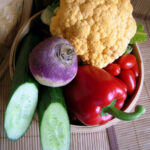Starting a vegan diet can be a healthy choice for adults who want to eliminate all animal products from their diet. The vegan diet takes a vegetarian diet one step further, and it eliminates all animal products, including dairy and eggs. The vegan diet takes discipline, commitment and awareness if you intend to make a permanent diet and lifestyle change.
Why Go Vegan?
This is not a call to action, these are simply some reasons that people choose to go vegan. Some reasons are personal, others are seen as political.
Animal Rights – A vegan diet may suit your lifestyle better if you are concerned about animal rights.
Green Reasons – Studies show that it takes more energy and more fossil fuels and water to produce meat for food than it does to produce vegetables. (World Watch Institute).
Health Reasons – There are numerous health benefits of going vegan, according to the American Dietetic Association. Your consumption of saturated fat and cholesterol will be lowered. With a vegan diet you will naturally increase your intake of fiber, Folate and antioxidants (ADA). A vegan lifestyle is also a preventive way to reduce the chance of developing high blood pressure an diabetes.
Religious or Spiritual Reasons – You may want to better align your diet with your religious or spiritual beliefs.
Benefits of a Vegan Diet
A vegan diet can be less expensive than a meat and dairy-based diet. Because many of the staples of a vegan diet can be purchased as whole foods, not as processed foods, they can be cheaper. Fruits and vegetables tend to be cheaper than either meat or dairy, especially in in the last few years where dairy products have increased.
Cooking foods with beans and legumes is also cheaper. A bag of lentils, raw chick peas or raw kidney beans costs about a dollar. Even a can of already cooked beans may cost about a dollar, and can provide the protein you need.
Transitioning to a Vegan Diet
Transitioning to a vegan diet can be difficult if you are accustomed to eating dairy and meat every day. Cutting out meat first is the easiest step for starting a vegan diet. If you cannot give up eating meat cold turkey, cut back to three times a week, to one time a week, to none at all. It may be easier to drop one food a week, from the dairy group as well, rather than eliminating everything all at once. It depends on your willpower and underlying reasons for choosing a vegan diet.
If you want to make a serious lifestyle change, there is nothing wrong with a gradual change from a carnivorous diet to a vegan diet. If you drop all meat and dairy at once, you may find yourself feeling deprived of some of your former favorite foods. When you drop one or two foods at time, it gives you a chance to find healthy substitutes. For example, an all-fruit sorbet can take the place of your favorite ice cream.
Disadvantages to Starting a Vegan Diet
Starting and maintaining a vegan diet will be difficult if you rely heavily on processed and packaged foods, or if you eat a lot of meals at restaurants. Pre-packaged foods tend to use animal products even when they are not necessary for the product. For example, a can of vegetable soup may be made with beef or chicken broth.
Another disadvantage to starting a vegan diet is that unless you eat only fresh foods and prepare all of your meals at home, even animal-free products may not be 100% vegan. Some vegan foods may be prepared with the same utensils and bowls as foods containing dairy and meat products. There are currently no government standards or labeling guidelines that are required to distinguish between 100 percent vegan ingredients and preparation, and other foods.
The solution to this, if you want to be able to buy vegan foods which have been prepared away from animal and dairy products is to shop in the kosher section of the grocery store and look for foods labeled as pareve. These foods have not been prepared with dairy or meat.
Stumbling Blocks
Other stumbling blocks you may find is that there are times when you do not have time to prepare a healthy and well-balanced meal yourself. Make two or three servings of a vegan meal when you cook, an flash freeze the extra servings in an air-tight container for quick use.
If you become pregnant while on a vegan diet, it may be hard to stick with it. With pregnancy, your body’s nutritional needs change, and so do your tastes and cravings. If you feel the need to have some dairy or meat products during pregnancy, although you are trying to be vegan, give yourself a break and do what you need to do for you and your baby. You can always resume a vegan diet again after you give birth, or when you stop breast feeding.
Tips for Sticking with a Vegan Diet
A vegan diet is easier to stick with when either your entire family is on the same diet, or if you eat most of your meals solo.
Find a soy milk you like, since cow’s milk will not be part of the vegan diet. A refrigerated soy milk has better flavor and consistency than the room-temperature soy milks on the grocery store shelf. Silk is the best tasting brand of soy milk.
Do not be too hard on yourself if you occasionally consume a dairy or meat product. This is bound to happen when you eat out or eat a meal that someone else has prepared.
Locate soy substitutes including soy cheese or soy milk for some foods.
Eat vegan meals at local vegetarian restaurants to expand your ideas of the types of animal-free meals you can make at home.
Do not try to substitute all of your formerly favorite meat and dairy products with vegan versions. Enjoy fruits, vegetables, grains and legumes for what they are.
Sources
American Dietetic Association
ChooseVeg.com, http://www.chooseveg.com
Personal Experience





